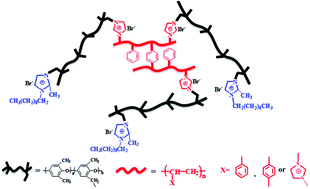Formation and investigation of dual cross-linked high temperature proton exchange membranes based on vinylimidazolium-functionalized poly(2,6-dimethyl-1,4-phenylene oxide) and polystyrene†
Abstract
A 1-decyl-2-methylimidazole (DMIm) functionalized poly(2,6-dimethyl-1,4-phenylene oxide) (PPO) membrane is fabricated and employed to dope phosphoric acid (PA) for use as a high temperature proton exchange membrane. This kind of membrane displayed superior PA doping capability, but poor mechanical properties. In order to improve the dimensional and mechanical stabilities without sacrificing proton conductivities, a series of dual cross-linked membranes are prepared using the poly(styrene-vinylimidazole-divinylbenzene) (poly(St-VIm-DVB)) copolymer as a crosslinker. The reaction of vinylimidazole with benzyl bromide not only constructs a cross-linking network, but also endows the membranes with a PA doping capacity for proton conduction. The reticular polymer chain structure improves the mechanical properties of the membranes, especially at elevated temperatures. As an example, PPO-70%VIm-30%DMIm/180.1%PA achieves a high proton conductivity of 0.067 S cm−1 at 180 °C without humidification, while it displays suitable tensile strengths of 5.0 MPa and 2.1 MPa at room temperature and 120 °C, respectively. These membranes show great potential for use as an electrolyte in high temperature proton exchange membrane fuel cells.



 Please wait while we load your content...
Please wait while we load your content...